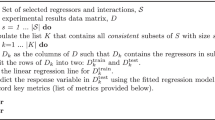Abstract
This article considers robust designs for safety and quality critical processes. In critical processes, the choice of control settings should ensure that the product quality remains near the target for each and every value of the noise variable. This objective is realized by using a min-max approach which minimizes the maximum possible deviation (caused by noise) of the estimated response from the target value. An algorithm for computing such control settings based on entropic regularization is discussed. The proposed method is used on automobile crash test data to select maximally safe designs for the interior rim of cars. A second example on the design of drug granulation parameters to produce uniformly sized granules is also included.



Similar content being viewed by others
References
Copeland, K.A.F., and P.R. Nelson. 1996. Dual response optimization via direct function minimization. Journal of Quality Technology 28:331–336.
Del Castillo, E., S.K. Fan, and J. Semple. 1997. Computation of global optima in dual response systems. Journal of Quality Technology 29:347–353.
Del Castillo, E., and D.C. Montgomery. 1993. A nonlinear programming solution to the dual response problem. Journal of Quality Technology 25:199–204.
Dette, H., L. Haines, and L. Imhof. 2003. Bayesian and maximin optimal designs for heteroscedastic regression models. Canadian Journal of Statistics 33:221–241.
Evans, L.C., and R.F. Gariepy. 1992. Measure theory and fine properties of functions 2nd edn. Boca Raton, Florida: CRC Press.
Fan, S.K.S. 2000. A generalized global optimization algorithm for dual response systems. Journal of Quality Technology 32:444–456.
Huyer, W., and A. Neumaier. 1999. Global optimization by multilevel coordinate search. Journal of Global Optimization 14:331–355.
Jones, D.R., C.D. Perttunen, and B.E. Stuckman. 1993. Lipschitzian optimization without the lipschitz constant. Journal of Optimization Theory and Applications 79:157–181.
Kacker, R.N. 1985. Off-line quality control, parameter design, and the Taguchi method. Journal of Quality Technology 17:176–209.
Kiwiel, K. 1987. A direct method of linearization for continuous minimax problems. Journal of Optimization Theory and Applications 55:271–287.
Lin, D.K.J., and W. Tu. 1995. Dual response surface optimization. Journal of Quality Technology 27:34–39.
Mukherjee, R., and S. Huda. 1985. Minimax second- and third-order designs to estimate the slope of a response surface. Biometrika 72:173–178.
Myers, R.H., A.I. Khuri, and G.G. Vining. 1992. Response surface alternatives to the Taguchi robust parameter design approach. The American Statistician 46:131–139.
Nair, V.N. 1992. Taguchi’s parameter design: A panel discussion. Technometrics 34:127–161.
Ogawa, S., T. Kamijima, Y. Miyamoto, M. Miyajima, H.K.T. Sato, and T. Nagai. 1994. A new attempt to solve the scale-up problem for granulation using response surface methodology. Journal of Pharmaceutical Sciences 83:439–443.
Parpas, P., B. Rustem, and C. Pantelides. 2009. An algorithm for the global optimization of a class of continuous minimax problems. Journal of Optimization Theory and Applications 141:461–473.
Pickle, S.M., T.J. Robinson, J.B. Bircha, and C.M. Anderson-Cook. 2008. A semi-parametric approach to robust parameter design. Journal of Statistical Planning and Inference 138:114–131.
Polak, E. 1994. Optimization: Algorithms and consistent approximations 2nd edn. New York: Springer.
Polyak, R.A. 1988. Smooth optimization methods for minimax problems. SIAM Journal on Control and Optimization 26:1274–1286.
Rai, B., N. Singh, and M. Ahmed. 2005. Robust design of an interior hard trim to improve occupant safety in a vehicle crash. Reliability Engineering and System Safety 89:296–304.
Robinson, T.J., C.M. Borror, and R.H. Myers. 2004. Robust parameter design: A review. Quality and Reliability Engineering International 20:81–101.
Rustem, B., and Q. Nguyen. 1998. An algorithm for inequality constrained discrete min-max problems. SIAM Journal on Optimization 8:256–283.
Rustem, B., S. Zakovic, and P. Parpas. 2008. An interior point algorithm for continuous minimax: Implementation and computation. Optimization Methods and Software 23:911–928.
Sasai, H. 1974. An interior penalty method for minimax problems with constraints. SIAM Journal of Control 12:643–649.
Sheu, R.L., and J.Y. Lin. 2004. Solving continuous min-max problems by an iterative entropic regularization method. Journal of Optimization Theory and Applications 121:597–612.
Sitter, R.R. 1992. Robust designs for binary data. Biometrics 48:1145–1155.
Taguchi, G. 1986. Introduction to quality engineering. White Plains, NY: UNIPUB/Kraus International.
Taguchi, G., and Y. Wu. 1985. Introduction to off-line quality control. Nagoya, Japan: Central Japan Quality Control Association.
Vining, G.G., and R.H. Myers. 1990. Combining Taguchi and response surface philosophies: A dual response approach. Journal of Quality Technology 22:38–45.
Vojnovic, D., D. Chicco, and H. El Zenary. 1996. Doehlert experimental design applied to optimization and quality control of a granulation process in a high shear mixer. International Journal of Pharmaceutics 145:203–213.
Vojnovic, D., M. Moneghini, F. Rubessa, and A. Zanchetta. 1993. Simultaneous optimization of several response variables in a granulation process. Drug Development and Industrial Pharmacy 19:1479–1496.
Welch, W.J., T.K. Yu, S.M. Kang, and J. Sacks. 1990. Computer experiments for quality control by parameter design. Journal of Quality Technology 22:15–22.
Zakovic, S., B. Rustem, and C. Pantelides. 2000. An interior point algorithm for computing saddle points of constrained continuous minimax. Annals of Operational Research 99:59–78.
Author information
Authors and Affiliations
Corresponding author
Additional information
Grant Sponsor: Department of Science and Technology, SR/FTP/MS-13/2009.
Rights and permissions
About this article
Cite this article
Mukhopadhyay, S., Chakraborty, D. A computational algorithm for selecting robust designs in safety and quality critical processes. Sankhya B 73, 105–122 (2011). https://doi.org/10.1007/s13571-011-0021-0
Received:
Revised:
Accepted:
Published:
Issue Date:
DOI: https://doi.org/10.1007/s13571-011-0021-0




